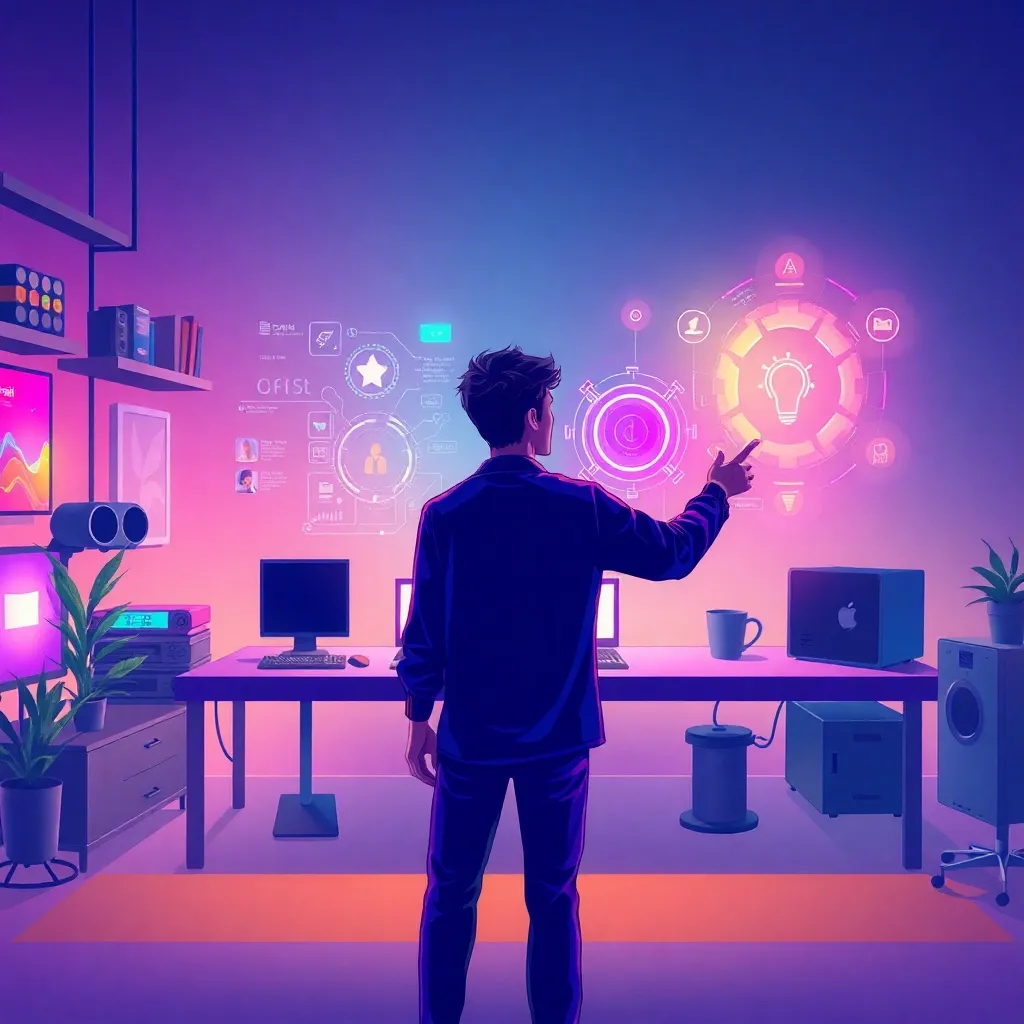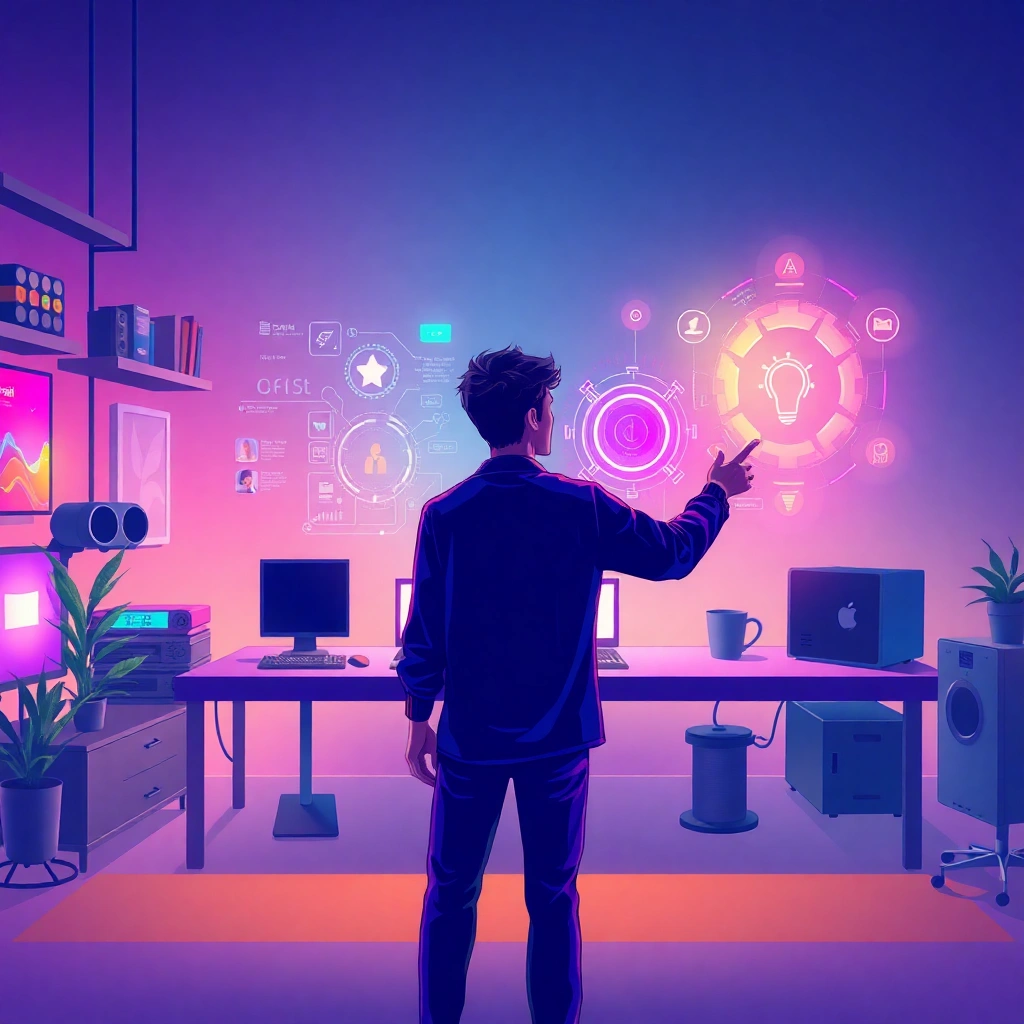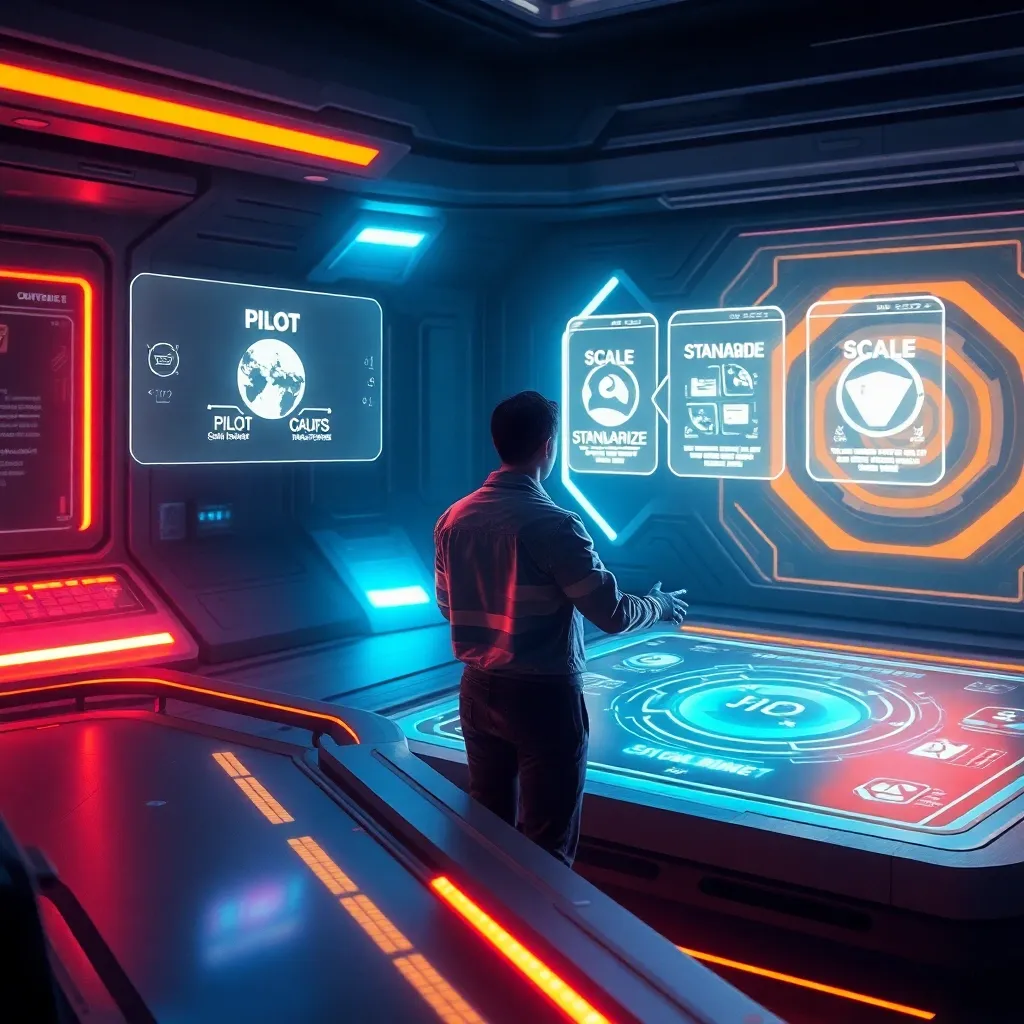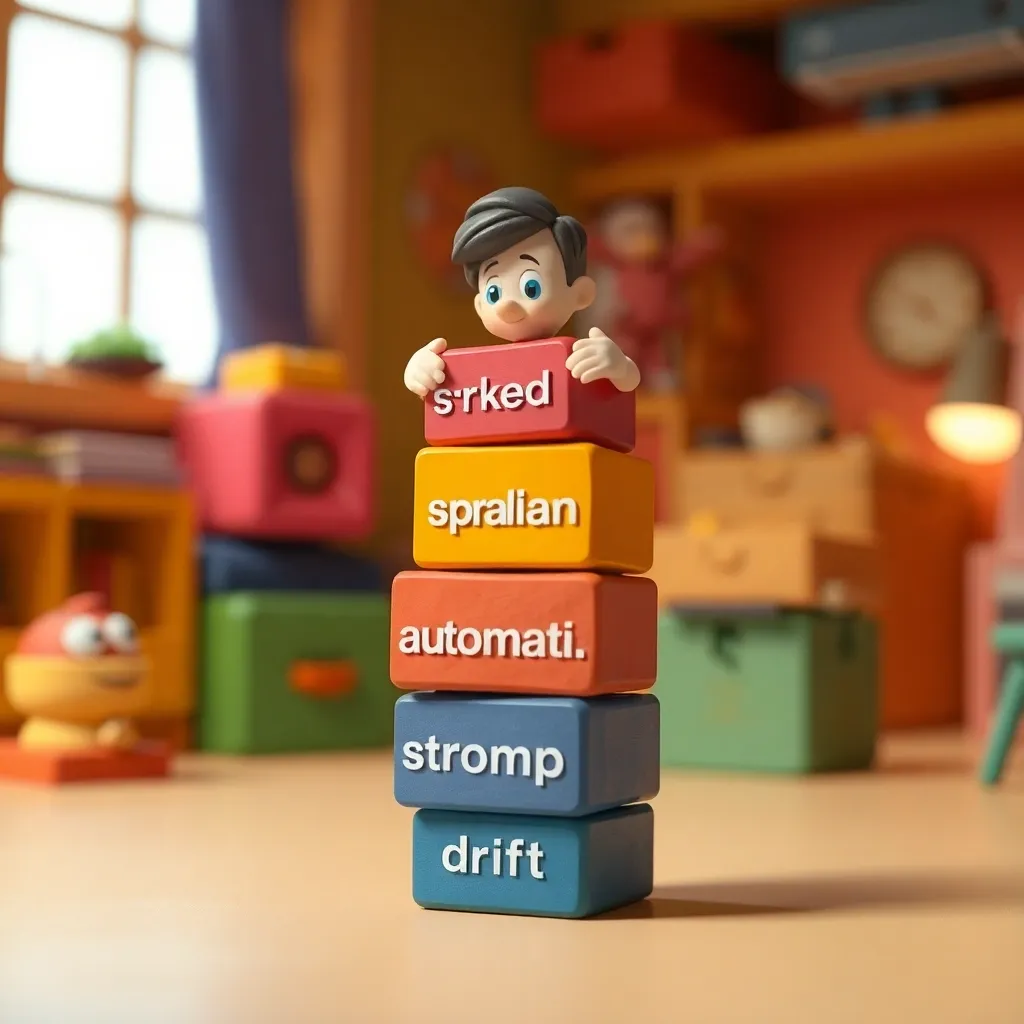Demystifying AI: How Marketing Teams Can Leverage AI Tools
- Why Marketing Teams Need AI Now
- The “Demystifying Marketing AI” Playbook
- Where AI Delivers the Biggest Wins (Right Now)
- The Case for a Unified AI Studio
- A Practical Framework: Pilot, Standardize, Scale
- Evaluating AI Platforms: A 12-Point Checklist
- Prompting Playbooks for Marketing Teams
- Governance Without the Headaches
- Measuring What Matters: AI ROI for Marketers
- Real-World Scenarios
- 30-60-90 Day Adoption Plan
- Common Pitfalls (And How to Avoid Them)
- Advanced Marketing Technology Insights
- How Mad Bot Art Fits Your Stack
- Quick-Start Templates You Can Reuse
- FAQs: Demystifying Marketing AI for Leaders
- Conclusion: Turn Possibility into Process

Demystifying AI: How Marketing Teams Can Leverage AI Tools
Marketing is shifting from campaign-by-campaign execution to a continuous, data-aware content engine. AI is no longer a novelty; it’s a practical layer that helps teams plan smarter, produce faster, and measure better. This article demystifies how to put AI to work across your entire marketing lifecycle—so you can move from experimentation to repeatable, AI-driven productivity without sacrificing brand standards or governance.
You’ll find practical frameworks, prompts, adoption checklists, and a look at how a unified studio like Mad Bot Art can centralize production, collaboration, and ROI tracking. If you’ve been looking for a grounded guide to leveraging AI for marketing, you’re in the right place.
Why Marketing Teams Need AI Now
Budgets are tight. Content volume is soaring. Stakeholders expect personalization, omnichannel quality, and measurable impact—yesterday. That’s where AI Tools For Productivity shine. When thoughtfully implemented, AI can:
- Reduce cycle times on content creation by 40–70%
- Turn raw market signals into Effective Marketing Strategies faster
- Improve quality and consistency (brand voice, design systems, compliance)
- Accelerate testing and iteration with synthetic variants and structured feedback loops
- Unlock AI-driven Productivity without inflating headcount
But success requires more than plugging in a model. It requires Demystifying Marketing AI—how it works, where it fits, and how to govern it. This article gives Marketing Technology Insights and a proven path for Streamlining Marketing Processes across planning, production, and performance management.
The “Demystifying Marketing AI” Playbook
Think of AI as a set of capabilities—language understanding, image/video generation, retrieval and summarization, pattern detection—rather than a single tool. To make it actionable, map capabilities to stages of your marketing workflow:
-
Strategy
- Competitive intelligence, demand mapping, persona refinement
- Messaging frameworks and value prop testing
- Marketing Technology Insights that turn data into direction
-
Planning
- Campaign outlines, calendars, offers, channel mixes
- Budget scenarios and test plans
- AI Applications For Teams that align stakeholders in minutes
-
Production
- Copy, design, motion, voice, and interactive assets
- Localization and accessibility
- On-brand automation with approvals and version control
-
Distribution
- Channel-specific formatting and SEO
- Paid/organic variations
- AI In Team Collaboration to coordinate handoffs seamlessly
-
Optimization
- Multivariate creative testing
- Insight summaries and “next action” recommendations
- Enhancing Team Performance through closed-loop learning
When teams adopt AI across these layers, they’re not just Leveraging AI For Marketing—they’re building a compound advantage that grows more valuable with every campaign.
Where AI Delivers the Biggest Wins (Right Now)
Below are high-ROI use cases that combine AI Tools For Productivity with strong governance.
1) Research and Strategy Acceleration
- Competitor sweeps summarized into actionable one-pagers
- Persona enrichment using customer voice-of-customer analysis
- Positioning matrices created from transcripts, G2 reviews, and SERP snapshots
- Messaging frameworks checked for clarity and differentiation
Keywords in action:
- These workflows are essential to Demystifying Marketing AI by narrowing noise into signal.
- They surface Marketing Technology Insights you can act on this quarter.
- They are prime examples of AI Applications For Teams that need strategic alignment.
2) Content Pipeline Modernization
- Campaign briefs expanded into cross-channel calendars
- Blogs, emails, and social copy drafted in brand voice with citations
- Landing pages auto-structured for SEO and conversion fundamentals
- Localization and repurposing at scale
Keywords in action:
- AI Tools For Productivity help editors shift time from drafting to polishing.
- Streamlining Marketing Processes ensures consistent, Effective Marketing Strategies.
3) Multimedia and Creative Production
- Style-consistent images, short-form video, and narration
- Script-to-screen workflows with scene editors and automated b-roll
- Voice cloning and avatars for tutorials, explainers, and ads
- Brand-safety guardrails and approvals built into the flow
Keywords in action:
- AI-driven Productivity in multimedia lets you scale asset depth without headcount.
- AI In Team Collaboration ensures creative and brand teams stay aligned.
4) SEO and Demand Generation
- Keyword clustering, SERP gap analysis, and authority mapping
- Outline-to-draft automation with originality checks
- Internal linking and schema recommendations
- Competitor monitoring with content refresh triggers
Keywords in action:
- Leveraging AI For Marketing in SEO is a foundational investment.
- Marketing Technology Insights guide what to publish and when.
5) Personalization and Lifecycle Marketing
- Segment-specific variations for email, ads, and landing pages
- Dynamic content blocks for onboarding, upsell, and retention
- Pacing and frequency tuning by user cohort
- Creative “libraries” that adapt to persona traits
Keywords in action:
- AI Applications For Teams that manage the user journey can lift LTV.
- Enhancing Team Performance by aligning lifecycle, creative, and analytics.
6) Analytics and Decision Support
- Performance summaries and “what changed?” diagnosis
- Automated test planning and experiment analysis
- Forecasts that connect content velocity to pipeline metrics
- Budget allocation recommendations
Keywords in action:
- Demystifying Marketing AI means trusting but verifying AI’s advice.
- AI-driven Productivity thrives when analytics and production share context.
The Case for a Unified AI Studio
Many teams begin their AI journey with a handful of tools. Quickly, they run into fragmentation: drafts in one app, visuals in another, approvals and billing elsewhere, and no central audit trail. A unified platform reduces risk and accelerates value.
Mad Bot Art is one such unified AI production studio built for marketing-grade output. It lets teams script, design, animate, narrate, and ship brand-ready media from one workspace. That single pane helps with:
- Strategy-to-delivery continuity: Start with briefs and evolve into multimodal outputs—text, image, video, voice, and SEO content—without bouncing between tools.
- Collaboration and governance: Real-time co-editing, autosave-by-default editors, versioned projects, and approvals reduce production risk.
- Monetization and ROI: Credit wallets, Stripe billing, usage analytics, and profitability dashboards make procurement and chargebacks straightforward.
- Extensibility: A connector registry and modular services make it easy to adopt new models and features.
Explore how a unified studio can power AI-driven Productivity and Streamlining Marketing Processes here: Mad Bot Art
A Practical Framework: Pilot, Standardize, Scale
Use this three-phase approach to make Leveraging AI For Marketing predictable and governable.
Phase 1: Pilot (0–30 days)
- Pick 2–3 high-impact workflows (e.g., blog drafting, social visuals, competitor briefs).
- Define success metrics (turnaround time, quality thresholds, engagement).
- Build a prompt library and brand guidelines for consistency.
- Run internal QA with a single team or region.
Keywords in action:
- Demystifying Marketing AI starts with small wins and tight feedback loops.
- AI Tools For Productivity should complement, not replace, human judgment.
Phase 2: Standardize (31–60 days)
- Create templated workflows, approval paths, and asset kits.
- Integrate SEO planners with content and creative production.
- Roll out AI In Team Collaboration norms: file naming, versioning, comments.
- Implement governance: role-based access, audit logs, and brand kits.
Keywords in action:
- Streamlining Marketing Processes reduces rework and error rates.
- Marketing Technology Insights turn into repeatable, Effective Marketing Strategies.
Phase 3: Scale (61–90 days)
- Expand to multimedia (video, voice, avatars) and localization.
- Implement ROI dashboards by campaign, region, and channel.
- Formalize change management and training across teams.
- Launch agency or partner workflows if relevant.
Keywords in action:
- AI Applications For Teams scale best with cross-functional champions.
- Enhancing Team Performance through shared learnings and playbooks.
Evaluating AI Platforms: A 12-Point Checklist
Use this checklist when selecting tools to ensure AI-driven Productivity at scale:
- Multimodal depth: Does it cover text, images, video, audio, and avatars?
- Brand governance: Can you set brand kits, tone, and approvals?
- Collaboration: Real-time co-editing, comments, roles, and version history
- SEO integration: Research, drafting, and on-page refinement in one workflow
- Extensibility: A connector model to swap or add new frontier models
- Security and compliance: SSO, data retention controls, audit logs
- Export maturity: MP4, PDF, ZIP, and channel-ready formats
- Analytics: Usage, cost, and ROI attribution per account or campaign
- Billing and monetization: Credits, Stripe integration, and chargeback support
- Autosave and resilience: Reduce production risk and content loss
- Localization: Style transfer and translation with human-in-the-loop QA
- Support and training: Prompt libraries, onboarding, and success resources
Mad Bot Art checks these boxes by unifying strategy, production, SEO, approvals, and billing in a single environment purpose-built for marketing teams. Learn more at Mad Bot Art
Prompting Playbooks for Marketing Teams
Strong prompts reduce back-and-forth and embody Effective Marketing Strategies. Try these patterns, then save your winners as templates.
-
Strategy Summary
- “Synthesize the top 5 competitor messages for [product] targeting [persona]. Produce a table with differentiators, proof points, and CTA styles. End with 3 counter-positioning angles.”
-
Campaign Structure
- “Create a 6-week campaign plan for [goal], channels [X, Y, Z], budget [range]. Include offer, content themes, A/B test ideas, and email cadence. Output a calendar and asset checklist.”
-
Brand Voice
- “Rewrite this paragraph in [brand voice] for [audience]. Maintain [tone], avoid [jargon]. Provide 3 variants with different hooks and preview snippets for email.”
-
SEO Draft
- “Using the outline below, draft an article targeting [keyword cluster]. Include H2/H3s, internal link suggestions, and schema notes. Highlight sections needing SME review.”
-
Creative Brief to Storyboard
- “Turn this creative brief into a 30-second video storyboard with 6 scenes, on-screen text, VO script, and suggested b-roll. Conform to [brand kit] color and typography.”
-
Personalization
- “Generate three landing page headline/subhead pairs for [persona] in [industry]. Emphasize [pain points] and proof tied to [metric]. Include variants for awareness vs. decision stage.”
These prompts accelerate AI Tools For Productivity and serve as living documentation for AI In Team Collaboration.
Governance Without the Headaches
Brand safety and compliance are mandatory. Bake governance into workflows:
- Brand kits and voice rules in your AI workspace
- Approval gates for regulated content and high-visibility assets
- Role-based permissions for creators vs. reviewers vs. clients
- Audit trails for edits, exports, and sign-offs
- Human-in-the-loop checkpoints for sensitive claims
Mad Bot Art supports this model with autosaving editors, versioned projects, approvals next to generation, and analytics that attribute usage to campaigns and accounts. This is key to streamlining marketing processes while Enhancing Team Performance.
Measuring What Matters: AI ROI for Marketers
Focus on the metrics that tie AI-driven Productivity to business outcomes.
-
Efficiency
- Output per person-hour
- Time-to-first-draft and time-to-approval
- Asset reuse and localization velocity
-
Effectiveness
- Organic rankings, CTR, and SERP share
- Lift in conversion rate or pipeline contribution
- Creative test win rate and iteration speed
-
Financials
- Cost per asset by type and channel
- ROI by campaign (spend vs. revenue or pipeline)
- Budget reallocation impact on performance
With Mad Bot Art, teams can track spend, usage, and ROI at the account or project level. That financial visibility makes Leveraging AI For Marketing a board-level conversation backed by data, not anecdotes.
Real-World Scenarios
Here are two scenarios that show AI Applications For Teams across the lifecycle.
Scenario 1: B2B SaaS Launch
- Objective: Launch a new module to mid-market buyers in North America and EMEA.
- AI Flow:
- Research: Competitor and SERP analysis identify content gaps.
- Strategy: Messaging pillars and objection handling are drafted and approved.
- Production: Blog cluster, landing pages, explainer video, and email sequences built with brand kits.
- Localization: EMEA variants generated and reviewed.
- Distribution: Channel-ready exports and UTM-tagged links.
- Optimization: AI summarizes performance and proposes tests.
- Outcome: 40% faster production, 18% higher landing page conversion after 3 test cycles, clear ROI attribution.
- Keywords in action: This shows Demystifying Marketing AI in practice and Streamlining Marketing Processes with AI Tools For Productivity.
Scenario 2: Agency Content Retainer
- Objective: Deliver 40 monthly assets across four clients with strict brand controls.
- AI Flow:
- Workspaces per client with credit wallets and approvals
- Shared prompt libraries for voice consistency
- SEO workbench feeding production for each client’s calendar
- Profitability dashboards to track margins per retainer
- Outcome: Asset quality up, revisions down, margin transparency per client.
- Keywords in action: AI In Team Collaboration and Enhancing Team Performance enable Effective Marketing Strategies at scale.
30-60-90 Day Adoption Plan
30 Days
- Select 3 use cases: SEO drafts, social video, competitor briefs
- Stand up brand kits and approval gates
- Train a pilot squad; document prompts and outcomes
- Baseline metrics: cycle time, revision rate, performance
60 Days
- Expand to email sequences, landing pages, and voiceover videos
- Launch a weekly “AI ops” standup to share learnings
- Connect analytics to campaign dashboards
- Standardize templates and naming conventions
90 Days
- Add localization and asset reuse automation
- Roll out cross-functional training to sales and success
- Implement ROI dashboards and budget planning with AI recommendations
- Codify playbooks into onboarding for new hires
This cadence turns Leveraging AI For Marketing into a managed transformation, not a one-off tool test.
Common Pitfalls (And How to Avoid Them)
- Tool sprawl: Consolidate into a unified platform where possible.
- Over-automation: Keep SMEs in the loop for claims, strategy, and high-stakes assets.
- Prompt drift: Maintain a versioned prompt library tied to brand and channel.
- KPI blindness: Tie AI-driven Productivity to funnel metrics, not vanity stats.
- Governance gaps: Use approvals, roles, and audit logs to protect brand trust.
Mad Bot Art addresses these with an all-in-one studio for planning, creative production, SEO, collaboration, and monetization. See how it works at Mad Bot Art
Advanced Marketing Technology Insights
As your maturity grows, expand your practice:
- Retrieval-augmented generation (RAG) for knowledge-grounded content
- Synthetic dataset creation for creative testing
- Model ensembles for accuracy and creativity balance
- Automated linking between insights and production (e.g., SERP gaps to content tickets)
- Asset lifecycle metadata for reuse recommendations
Each initiative strengthens your capability stack and fuels Streamlining Marketing Processes while Enhancing Team Performance.
How Mad Bot Art Fits Your Stack
Mad Bot Art brings together the capabilities marketers actually need:
- Multimodal creation: On-brand copy, visuals, videos, audio, and avatars via curated model presets and prompt enhancers.
- End-to-end orchestration: Projects, timelines, scene editors, and real-time collaboration to power AI In Team Collaboration.
- SEO workspace: Competitor analysis, article drafting, and refinement tools living next to creative production.
- Operational rigor: Autosave-by-default editors and versioned projects to reduce risk.
- Monetization and analytics: Credit wallets, Stripe billing, and profitability dashboards to quantify ROI.
In short, it’s a single AI studio to plan, produce, and profit from every campaign asset. For teams committed to Demystifying Marketing AI and building Effective Marketing Strategies, it’s a pragmatic way to turn experimentation into scale.
Quick-Start Templates You Can Reuse
Campaign Brief Template
- Objective and KPI
- Audience and persona notes
- Messaging pillars and proof
- Channels, budget, and timeline
- Asset list with owners and due dates
- Approval chain and QA criteria
SEO Article Template
- Target keyword cluster and search intent
- Outline with H2/H3s and internal link targets
- Draft with calls-to-action and schema notes
- SME review checklist
- Refresh triggers (rank drop, SERP changes, product updates)
Video Script Template
- Hook, problem, solution, proof, CTA
- Scene-by-scene visuals and VO
- Brand kit references (fonts, colors, motion)
- Accessibility and localization notes
- Export specs per channel
These live templates boost AI Tools For Productivity, reduce handoffs, and create alignment for AI Applications For Teams.
FAQs: Demystifying Marketing AI for Leaders
Q: Will AI replace creative roles? A: No—AI amplifies human creativity and judgment. It automates lower-value tasks so talent can focus on strategy, storytelling, and quality.
Q: How do we maintain brand voice? A: Codify voice rules, examples, and forbidden phrases. Use brand kits and approval gates. Save high-performing prompts as templates.
Q: What about originality and SEO? A: Use grounded prompts, citations, and SME reviews. Pair AI drafting with human editing. Monitor rankings and engagement; refresh content based on signals.
Q: How do we justify budget? A: Track cycle time reductions, quality improvements, and business impact. Use ROI dashboards that connect usage to outcomes.
Q: What’s a smart first step? A: Start with 2–3 workflows (SEO drafts, video snippets, competitor briefs), measure results, then expand. A unified platform like Mad Bot Art reduces complexity as you grow.
Conclusion: Turn Possibility into Process
AI is not just another tool category—it’s an operating advantage. Teams that invest in Demystifying Marketing AI, adopt AI Tools For Productivity thoughtfully, and commit to Streamlining Marketing Processes will outperform on speed, quality, and cost. The payoff is more than content volume; it’s confidence in Effective Marketing Strategies shaped by real-time Marketing Technology Insights.
Whether you’re building your first prompt library or orchestrating global campaigns, focus on:
- A unified workspace to enable AI In Team Collaboration
- Governance that protects brand equity
- Clear metrics that prove AI-driven Productivity
- Playbooks that scale across AI Applications For Teams
- A partner platform that grows with you
If you’re ready to operationalize your next level of performance, consider a unified studio approach. Mad Bot Art brings planning, production, SEO, collaboration, and monetization into one environment so you can plan, produce, and profit—without the usual tool sprawl. Explore what your team could ship next at Mad Bot Art
By committing to this approach, you’re not just Leveraging AI For Marketing—you’re building a sustainable system for Enhancing Team Performance and compounding results, campaign after campaign.



